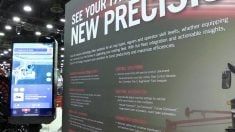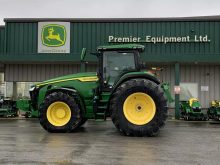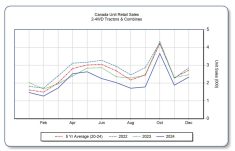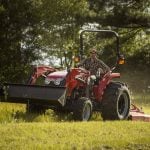John Deere recently unveiled its new line of 8RX rigid-frame, four-tracked model tractors.
Anyone who has walked the aisles at major farm machinery shows recently probably noticed four-tracked, rigid-frame tractors on display. But those are aftermarket track manufacturers retrofitting existing tractors.
John Deere is the first to offer such a design straight from the factory floor.
I took part in the media preview of Deere’s new tractors a few weeks ahead of their official introduction, along with a chance to get into their cabs and actually put them to work.
Read Also
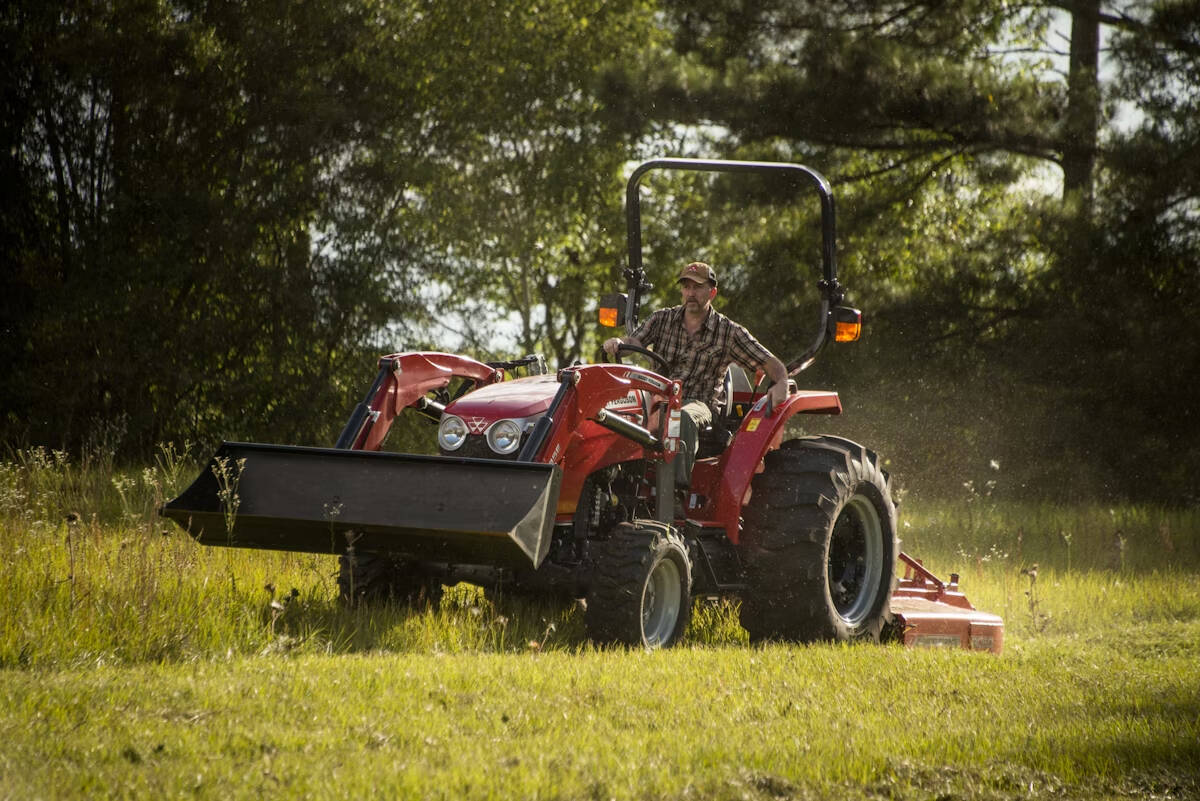
Agco settles legal dispute with TAFE
Agco and Tractors and Farm Equipment (TAFE) from India announced July 1 that they had settled their legal dispute, which began in 2024 over local ownership of the Massey Ferguson brand name and other concerns.
Four models make up the 8RX Series, which span the 310- to 410-horsepower range.
“Your initial blush when you see this machine right off might be, well, that’s an 8R wheel tractor with four tracks bolted onto it, right?” says Doug Felter, product marketing manager for mid-range and large tractors. “It’s anything but that. It’s a proper, ground-up, four-track tractor.”
One walk around an 8RX to take a look at its engineering makes it pretty obvious: these are no regular 8R tractors with minor modifications.
“This is really a ground-up tractor,” adds Aaron Ticknor, a senior marketing representative. “You’ll see undercarriage components like on the 8RT and 9RX. We’re building on platforms we’ve really had success with on wheels and tracks and integrating those into the 8RX.”
One of those components is a completely new front axle assembly for an 8 Series tractor.
“This front axle is what enables the four-track machine to function with the manoeuvrability of wheels,” adds Ticknor. “It has much larger components. It’s not an 8R with an aftermarket kit slapped on it. There’s a lot more power going through that front axle. There are upsized components on the rear axle as well.”

Those axles make the 8RX tractors stand a couple of inches taller than their other brothers in the 8 Series. And at the top of that higher cab roof is a built-in GPS receiver, a feature that will appear on all 7R and 8R tractors for the 2020 model year.
“With these new cabs, we’re going to see integrated StarFire receivers built right into them,” explains Felter. “It’s going to minimize the startup and the calibration necessary to get them off the truck and into the field running accurately.”
Driving the 8RX
So what’s it like to put an 8RX to work? We took one into a field behind Deere’s Waterloo, Iowa, assembly plant and did just that.
First and foremost, Deere’s marketing staff claims one of the advantages of the four-track models is they minimize berming in turns, something the two-track 8RT models are prone to do.
Working in the field, we found that the 8RX really didn’t create much ridging when making sharp turns in loose soil. So we buy that claim.
How are they to steer?
“This tractor turns and steers very, very well,” says Ticknor.
What did we find? Yes. We think that is a fair claim, too. The RXs felt just like a wheel tractor to steer during our field test. In fact, one of the most noticeable differences between the RX and RT tractors is in the steering. Turn the wheel on an RT when it is stationary and the entire tractor chassis pivots side to side because of the two-track design. Turn the wheel on an RX and only the front track modules move, just as the front wheels do on a wheeled tractor. And the turning radius felt very similar to wheeled 8Rs. There was no problem making sharp headland turns in the field.

We pulled some tillage implements in loose soil in the field and saw no significant wheel slip (or track slip, in this case). The grip felt pretty positive. Marketing staff says typical track slip should be down in the low single digits in most cases.
Axle spacing comes in 76-, 80-, 88- and 120 inch widths. If a second owner wants something different than the factory setting, Deere marketing staff says there will be parts available to change them outside the factory setting.
All in all, driving an RX felt almost exactly like piloting a regular 8R, except for experiencing the strange sight of two rubber tracks spinning up at the front end.
That’s right, new cabs
Yes, new cabs, too. Underneath those receivers, the cab on the 8RX, which will get shared with the other 8Rs and 7Rs, will grow a little bit bigger for 2020. The number of additional cubic feet isn’t large, but some repositioning of components inside makes them feel considerably bigger. Most notable is moving the HVAC components from the cab roof to behind the seat. That creates more headroom, something taller operators will appreciate.
“When we ask customers, they say they want a similar experience in their tractors like they have in their vehicles. So we’ve taken a lot of design cues from that, a lot of the fit and finish, the upholstery and the design features are inspired by that,” says Felter.
That includes the sound systems, with a new 6.5-inch touch screen now the control centre, with smartphone integration. Also included in the upgrade packages are features like enhanced lighting packages on the exterior of the cab.

Under the hood
Deere’s 9.0-litre PowerTech Plus diesel will fill the front end of all the 8RX tractors, and both the brand’s IVT and e23 powershift transmissions are available.
“On the e23, every gear has the same ratio split,” explains Dave Guetterman, product manager for 8R tractors.
“When customers talk about their old eight speeds, there’s always a jump between gear packs. You’re not going to see that on an e23. There are seamless, smooth shifts from one to 23. Plus, it gives us the ability to operate at a transport speed at reduced r.p.m., 26 m.p.h. at 1,500 r.p.m. It also gives us the ability to transport at up to 31 m.p.h. (50 km/h.).”
The difference is the tracks
But it’s those four-track modules they ride on that make the 8RX tractors unique.
“It will be offered in 18-, 24- and 30-inch tracks,” says Ticknor. “Thirty-inch tracks are only available on the back of the machine. So you cannot get 30-inch tracks up front. You can mix and match the track widths if you want.
“This tractor is going to come in at around 41,000 pounds on up to about 44,500. On ballast, this one doesn’t have that big of a flex. A customer won’t have to do much with ballast, largely because of the four tracks and the traction.”
The front and rear modules have some differences between them other than their size. On the front, there are two mid-rollers, which are fixed. At the back the three mid-rollers there are isolated and can follow contours.
“That’s really the difference between the front and rear,” explains Ticknor. “This is not a 9RX under-carriage slapped on the back of this tractor. It was designed specifically for this machine. Component-wise it’s a little bit smaller. We’re not just putting a generic assembly we have on the shelf on this tractor and calling it good enough.
“For clearance, we ended up pushing that rear hitch back a little bit. That’s going to eliminate striking an implement hitch with the back of the tracks.
“The four tracks give the 8RXs the “largest footprint and lowest ground pressure in the class,” Ticknor adds.
“We can even outdo the 8RT with about a 23 per cent larger footprint there and about 14 per cent lower ground pressure,” says Felter. “ (Comparing) an 8RX machine that has 18-inch tracks against a typical 480 (tire size) dualled row-crop tractor, a typical Midwestern configuration. When you look at the total pad area of the 8RX versus the 8R wheeled with full duals around it, you have about 39 per cent more footprint and about 28 per cent lower ground pressure.”
A new look
Deere has given the four-track 8RX tractor line new styling as well as new engineering.
To get the new lower hood profile, Deere engineers had to do some creative packaging with engine components, says Jeremy Elsbernd, engine application engineer. “One of the major changes you’ll see is an inline (exhaust) after treatment. It helps from a packaging perspective. It’s also downsized. That helps from a visibility perspective. It’s a DOC, DPF, SCR, all in there. That was huge for this program. Instead of having two cans, we have one. From a manufacturing perspective it’s easier.”
The 8RX four-track tractors, in addition to the existing 8RT two-track models, gives John Deere two distinct tracked 8R Series tractor lines, as well as the 9RX.
Does the introduction of the 8RX line mean the 8RTs are likely to fade away? Deere staff says absolutely not.
This article was originally published at Grainews.





